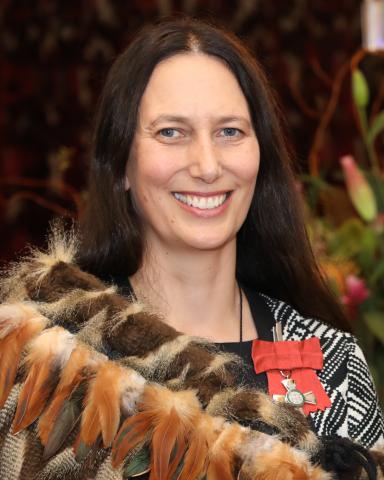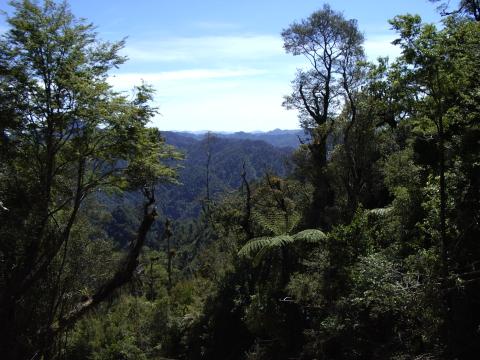Warrior Lawyer Profile: Jacinta Ruru

Gwen Hamilton
Allard Exchange Student 2022-2023, LLB Candidate University of Auckland
Jul 5, 2023
Using Legal Personhood to Respect and Protect Māori Worldviews
For Māori, the land that forms Aotearoa/New Zealand is Papatūānuku, Earth Mother, ancestor. To say that a place has legal personhood is to recognize and respect this ancestral connection. For years, Jacinta Ruru has been advocating for legal personhood to be granted to parts of the environment. Her work centres around the connection between Indigenous peoples and the land, and the importance of acknowledging Indigenous worldviews in the law. Of Raukawa, Ngāti Ranginui and Ngāti Maniapoto descent, she was raised in the deep south of Aotearoa’s South Island. She grew up at the head of Lake Wakatipu, the ancestral land of the Ngāi Tahu iwi (tribe).
A history of hostility and hope

Ruru’s childhood was marked by a constant feeling that something was lacking: while she was aware that the land had great significance to Māori, these stories were not spoken about in her communities. Every significant landmark around her was known by its English name and defined by its English history, masking the Indigenous connection to and knowledge of the land. This suppression of Indigenous knowledge continued through law school, which Ruru has described as a deeply hostile environment to Indigenous peoples. Such hostility is reflective of the history of colonization and displacement of Indigenous people in Aotearoa. Everywhere she looked, Ruru found that Indigenous knowledge was stripped and suppressed, resulting in a legal framework that reinforced colonization every step of the way.
Once she became aware of this absence, Ruru focused her attention on recognizing the Māori worldview in the legal system. Colonial laws, Ruru points out in her talk at the Centre for Law and the Environment’s First Annual Green Rights & Warrior Lawyers Virtual Academy, have suppressed the intergenerational responsibilities that Maori have to land. Throughout her career she has consistently advocated for Indigenous rights to be recognized in national parks in Aotearoa and Canada. In 2009, Ruru specifically addressed the question of legal personhood, supervising a thesis arguing for rivers to be given legal personality. This idea is directly connected to Ruru’s discomfort with the current state of the law: she has argued that recognizing Indigenous legal personality is a chance to “seismically shift” the biased foundation of colonization that Aotearoa law is built upon. Her work proved to be revolutionary for Aotearoa: In 2014, Ruru’s theories were put into action by the Aotearoa government, when the Te Urewera rainforest was granted legal personhood. The Whanganui River was next, with legal personhood granted in 2017 as part of the Whanganui Iwi Treaty settlement.
Te Urewera legal personhood in context
Ruru describes the Te Urewera Act as the most beautifully written statute ever, with a poetic acknowledgement of the spiritual and ancestral significance of the region. The Act even acknolwedges that “Te Urewera has an identity in and of itself, inspiring people to commit to its care.” This Act, and the legal personhood that it granted, arose out of a Treaty of Waitangi settlement with the Ngāi Tūhoe Indigenous people. The Treaty Settlement process in Aotearoa is designed to provide redress for the Crown’s breaches of Māori rights.

For the Tūhoe iwi, the Crown’s breaches involved confiscation of land and abuse of the iwi’s rights to sovereignty. By including legal personality as an element of the Treaty settlement, there was recognition that the Crown’s breaches had separated Māori from their ancestral land. The legal personhood was intended to help strengthen the connection between Tūhoe and Te Urewera by respecting the Tūhoe worldview. As Ruru argues, it is vital that Māori are given the ability to exercise tino rangatiratanga (sovereignty) over the land so that they can reshape conservation law to better serve and protect the land.
Changing how Aotearoa protects land
Ruru’s work on legal personhood is a testament to the importance of pushing boundaries in the law. Her work, and the legal developments that have arisen from it, are illustrative of two distinct changes in the way Aotearoa approaches environmental law. Firstly, legal personhood is used as a way to strengthen environmental protection by drawing on Indigenous practices. Ruru has persistently emphasized the importance of Indigenous knowledge in creating environmental policy; Māori have been caring for the land for centuries and understand the needs and markers of the land in a much more holistic way. Incorporating indigeneity into the framework of Aotearoa’s legal system helps to create the tools for stronger remedies and reinforcements for environmental protection.
Secondly, legal personhood of the environment reflects a new way of viewing the world — new for settler societies, that is. It is easy to see how Ruru’s work has been inspired by a desire to correct the absence of Indigenous knowledge that she felt so keenly growing up. As Ruru explains, “From the Māori perspective … our landscape is personified, we see the earth, our lands as our earth mother Papatuanuku.” Legal personhood puts this ancestral personification at the centre of Aotearoa’s legal understanding of the environment.
In some instances, legal personality can also represent an active form of decolonization. In the case of Te Urewera, the Indigenous Tūhoe people are “children of the mist,” and the Te Urewera rainforest is their ancestor. The Board appointed to help manage Te Urewera emphasizes that people are intrinsically linked to nature. They are able to carry this Tūhoe worldview into their management of the region. Similarly, recognition of the legal personhood of the Whanganui river reflects the intimate connection between the iwi and their ancestral river. Granting legal personality reflects an undeniable acceptance of the importance of this worldview.
Proceed with caution: Indigenous voices must be prioritized
While Ruru celebrates the changes in Aotearoa’s legal system, she also notes the dangers that a western perspective continues to present. Colonial biases are still present in conservation legislation in Aotearoa, as land set aside in national parks is viewed based on how humans can use and benefit from it. This is an exploitative lens that does not respect the intrinsic value of the environment. Although her research on legal personhood was done with the knowledge that the Whanganui iwi were making claims to the river, Ruru has since admitted that she never imagined that Aotearoa would implement these new concepts so quickly. Today Ruru voices the hope that more places around Aotearoa will be granted legal personhood. However, she warns us that this should only occur if the Indigenous people - the people who know the area best -- wish for this to happen. In this way, granting legal personality is not just about adding Indigenous tools to a Western toolbox. Legal personhood should be guided by the intention of giving effect to Indigenous worldviews. To do this, the law must genuinely respect the personality of the land.
Learn more about Jacinta Ruru and her work by watching her talk at the First Annual Green Rights & Warrior Lawyers Virtual Academy, November 10, 2022.
- Centre for Law and the Environment


